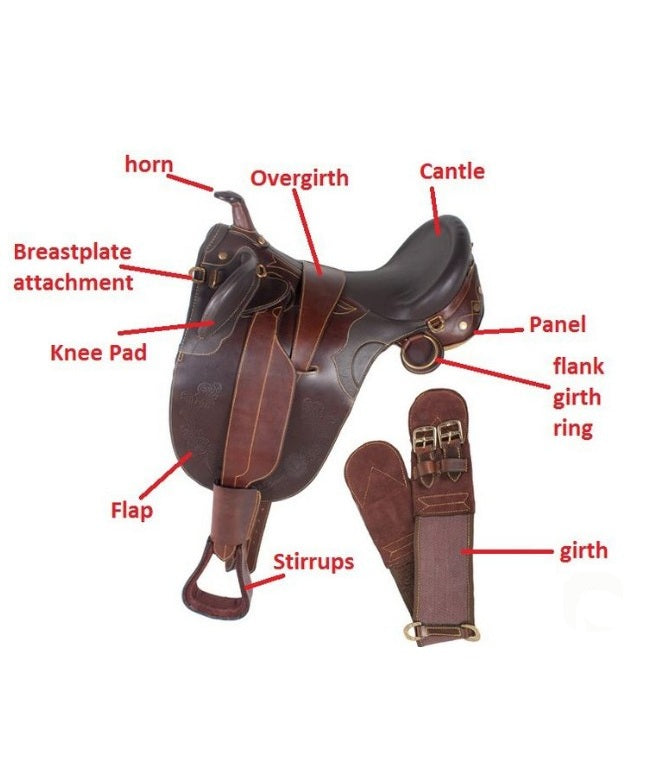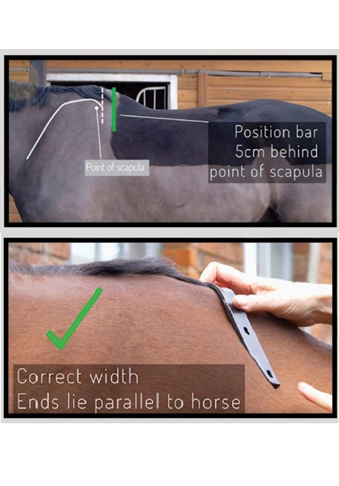How to Measure: Australian Saddles
The Australian Stock Saddle is renowned for its deep, secure seat and distinctive "poleys" (knee pads), offering exceptional stability for long hours in the saddle or rough terrain. Because of this unique design, measuring for an Australian saddle is different from measuring for an English or Western saddle. A proper fit is crucial to your security and your horse's comfort.
Here is a guide to the essential measurements you need before ordering your new stock saddle.
What You'll Need
- A flexible tape measure
- A piece of thick, flexible wire (like a coat hanger) or a flexible ruler
- A pen and paper

Step 1: Measuring for the Rider: Seat Size
The seat size in an Australian saddle is measured differently than in other saddles and often runs smaller. It’s measured from the inside base of the poley (knee pad) to the center of the cantle (the back of the seat).
- How to Estimate: Because the deep seat and poleys hold you securely in place, riders often take a smaller size. If you normally ride in a 17-inch English saddle, you might start looking at a 15.5-inch or 16-inch Australian saddle.
- Measurement Tip: The fit should allow about four inches of space between your body and the poley when you are sitting in the saddle. The poley should cradle your thigh without jamming your knee.
- Common Sizes: Adult sizes typically range from 14 inches to 17 inches.

Step 2: Measuring for the Horse: Tree Size (Gullet)
The tree width is the most critical measurement for your horse's comfort. An ill-fitting tree will cause pressure points and soreness.
- Gullet Width: The gullet is the space over the horse’s withers. To measure this, take your flexible wire and bend it to match the shape of your horse's back, two to three fingers' width behind the shoulder blade. Trace this template onto paper.
- Bar Angle: The angle of the bars (the parts of the saddle that run down the horse's back) must match the slope of your horse’s shoulders. The template you create will also help the supplier match this angle.
- Common Tree Sizes: Australian saddles are usually sized as Narrow, Medium (Standard), or Wide. The Standard or Medium fit is the most common and suits many typical Quarter Horse-type builds.

Step 3: Essential Saddle Dimensions
Beyond the fit, you need to consider how the saddle will sit on your horse's back.
- Skirt Length: The skirt is the part of the saddle that extends over the horse's back. Measure your horse's back from the back of the shoulder blade to the last rib. The saddle skirt must not extend past the last rib, or it will put pressure on the horse's loins.
- Weight: Australian saddles can be heavier than English saddles. Be sure to check the saddle's weight, especially if you have a smaller horse or plan to be tacking up frequently.

Important Tips for Sizing
Check the Brand's Chart: Australian saddle sizing is not standardized. A 16-inch seat from one brand may fit differently than a 16-inch seat from another. Always check the specific size chart for the brand you are buying.
Factor in the Poleys: The high, secure poleys mean you need less seat space than you might think. Don't size up just because the seat looks small; a tight fit is part of the saddle's design for security.
By accurately measuring your horse's back and considering your own proportions, you can confidently order an Australian Stock Saddle that provides the legendary comfort and security these saddles are known for.
Shop Australian Saddles
-
King Trekker Synthetic Endur Saddle with horn
5.0 / 5.0
(1) 1 total reviews
Regular price Starting at: $264.00Sale price Starting at: $264.00 Regular priceWas: $481.80Save: 45% off -
Australian Outrider Stock Saddle
2.0 / 5.0
(1) 1 total reviews
Regular price Starting at: $379.00Sale price Starting at: $379.00 Regular priceWas: $613.80Save: 38% off -
Australian Outrider Stock Saddle with Horn
Regular price Starting at: $379.00Sale price Starting at: $379.00 Regular priceWas: $613.80Save: 38% off -
Tough1 Leather Covered Padded Endurance Stirrups
Regular price Starting at: $49.95Sale price Starting at: $49.95 Regular priceWas: $72.56Save: 31% off -
AOC Stock Poley Wide Tree Saddle w. Horn
Regular price Starting at: $379.00Sale price Starting at: $379.00 Regular priceWas: $613.80Save: 38% off -
Australian Outrider Collection Outback Saddle
Regular price Starting at: $459.00Sale price Starting at: $459.00 Regular priceWas: $767.80Save: 40% off -
King Neutron Marathon Endurance Saddle
Regular price Starting at: $278.00Sale price Starting at: $278.00 Regular priceWas: $437.80Save: 37% off -
King Series Endurance Saddle with Horn
3.0 / 5.0
(1) 1 total reviews
Regular price Starting at: $390.00Sale price Starting at: $390.00 Regular priceWas: $745.80Save: 48% off -
Royal King McClellan Replica Cavalry Saddle
Regular price Starting at: $295.00Sale price Starting at: $295.00 Regular priceWas: $503.80Save: 41% off -
King Series Classic Distance Rider Saddle
Regular price Starting at: $413.00Sale price Starting at: $413.00 Regular priceWas: $723.80Save: 43% off



















